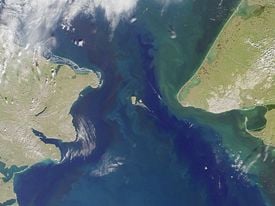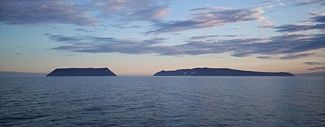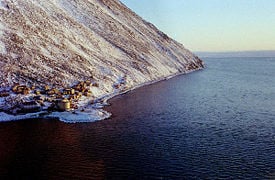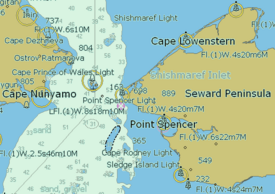Bering Strait
The Bering Strait (Russian: Берингов пролив Beringov proliv) is a formidable sea strait linking the icy Arctic Ocean with the Bering Sea. It separates the continents of Asia and North America at their closest point; Cape Dezhnev, Russia (169°43' W) and Cape Prince of Wales, Alaska (168°05' W). The latitude is approximately 65° 40' north, slightly south of the polar circle.
The boundary between the United States and Russia extends through the strait. While the Strait's narrowest point is about 53 miles (85 km) wide, two islands in its center, Little Diomede (U.S.) and Big Diomede (Russia), bring the distance of these two nations only 2.5 (4 km) miles apart at their closest point.
Although the Cossack Semyon Dezhnev sailed through the strait in 1648, it is named after Vitus Bering, a Danish-born Russian explorer who crossed the strait in 1728.
It is believed that there was a land bridge during the last Ice Age which allowed the crossing of man and mammal from Asia to the North American continent. Its crossing in recent history has been limited; during the Cold War years, it was known as the "Ice Curtain" border.
A Bering Strait bridge and tunnel system has been proposed, with connections to a highway system that would span the globe. Several organizations have pursued this goal, among them the Interhemispheric Bering Strait Tunnel and Railroad Group (IBSTRG), the Russian American Pacific Partnership (RAPP), and the Universal Peace Federation, which advocates a project known as the Bering Strait Peace King Tunnel. The construction of such a system would link Asia and North America, connecting the Eastern and Western Hemispheres. When completed there would be many commercial benefits. The connection would also serve to bring people of all races, cultures, religions, and nationalities into a prosperous and peaceful global community.
Geography
The Bering Strait is approximately 53 miles (85 km) wide at its narrowest, with an average depth of 30–50 meters (98–160 ft).
The Strait connects the Chukchi Sea (part of the Arctic Ocean) in the north with the Bering Sea (part of the Pacific Ocean) in the south. While some Bering Sea water passes through the strait into the Arctic Ocean, most of it returns to the Pacific.
Winter in the region is a season of severe storms, and a time when the Sea is covered by ice fields averaging four to five feet. Drift ice remains in the Strait even in mid-summer.
Land bridge
The Bering Land Bridge is believed to have existed during the last Ice Age due to the sea level falling several hundred feet. This land bridge, or isthmus, was roughly 1,000 miles (1,600 km) north to south at its greatest extent, which joined northeastern Asia to northwestern North America at various times during the Pleistocene ice ages. It was not glaciated because snowfall was extremely light due to the southwesterly winds from the Pacific Ocean having lost their moisture over the fully glaciated Alaska Range. The grassland steppe including the land bridge and stretching for several hundred miles into the continents on either side has been called Beringia.
The Bering land bridge is significant for several reasons, not least because it is believed to have enabled human migration to the Americas from Asia about 25,000 years ago.[1]
A study by geneticist Jody Hey[2] indicates that of the people migrating across this land bridge during that time period, only 70 left their genetic print in modern descendants, a minute effective founder population—unfortunately easily misread as though implying that only 70 people crossed to North America.
Seagoing coastal settlers may also have crossed much earlier, but scientific opinion remains divided on this point, and the coastal sites that would offer further information now lie submerged in up to a hundred meters of water offshore. Land animals were able to migrate through Beringia as well, bringing mammals that evolved in Asia to North America, such as proboscideans and lions, which evolved into now-extinct endemic North American species, and allowing equids and camelids that evolved in North America (and later became extinct there) to migrate to Asia.
Islands
The Bering Strait contains numerous islands, including the two Diomede Islands. Fairway Rock lies less than ten miles (15 km) to the southeast of the Diomedes. South of Strait lies St. Lawrence Island.
The Diomede Islands consist of two rocky, tuya-type islands: The U.S. island of Little Diomede and the Russian island of Big Diomede In the middle of the Bering Strait, the Big Diomede is Russia's easternmost point.
Because the International Date Line runs equidistant between the islands at a distance of 1.25 miles (2 km), the Russian and American sides are counted as falling on different calendar days, with Cape Dezhnev 21 hours ahead of the American side. This difference would be 24 hours, except that the U.S. has assigned all of Alaska, including Diomede, to the GMT -9 time zone. Russia has assigned its side of the strait to the GMT +12 time zone.
Population
The region around the Strait is sparsely populated. The Diomede Islands lie directly in the middle of the Bering Strait.
The native population of Big Diomede Island was relocated by the Soviet government to mainland Russia and the island is currently home to a small Russian military presence.[3]
Little Diomede has an Inupiat Eskimo population of 170,[4] mostly in the City of Diomede. This village has a school and a local store. Some of this island's native residents are famous for their walrus ivory carving. Mail is delivered by helicopter, weather permitting.
The area in the immediate neighborhood on the Alaskan side belongs to the Nome Census Area which had a recorded population of 9,126 people in the 2000 census. Other than snowmobile trails passable only during winter months, there are no roads linking Wales, AK on the U.S. shore of the strait to other areas of Alaska. Air and water are the main mode of travel. There are a few roads around Nome. There are no regular air connections across the strait, just a few summer charter flights. This is because of a Russian policy which only allows tourists in organized tours, with special permits required.
The Russian coast belongs to Chukotka Autonomous Okrug. Provideniya (4,500 people) and Chukotsky (5,200 people) are two larger settlements located at the Bering Strait. These areas are also roadless. The village of Uelen is just south of the Arctic Circle, also in Chukotka Autonomous Okrug. Located near Cape Dezhnev where the Bering Sea meets the Chukchi Sea, it is the easternmost settlement in Russia and the whole of Eurasia. Uelen is the closest Russian settlement to the United States.
The "Ice Curtain" border
Traditionally, the indigenous peoples in the area had frequently crossed the border between the United States and the Soviet Union for "routine visits, seasonal festivals and subsistence trade," but were prevented from doing so during the Cold War.[5] During this era the border became known as the "Ice Curtain."[6]
In 1987, an American long-distance open-water swimmer Lynne Cox symbolically helped ease tensions between the two countries by swimming across the border,[7] and was congratulated jointly by Ronald Reagan and Mikhail Gorbachev.
Expeditions
In 1987, swimmer Lynne Cox swam the 2.5 miles (4 km) between the Diomede Islands from Alaska to the Soviet Union in 40 °F (+4 °C) water during the last years of the Cold War.
In July 1989, a British expedition, Kayaks Across The Bering Strait, completed the first sea kayak crossing of the Bering Strait from Wales, in Alaska, to Cape Dezhneva, Siberia. The four expedition members, Robert Egelstaff, Trevor Potts, Greg Barton, and Peter Clark, kayaked from Nome up the Alaskan coast, round Cape Prince of Wales before crossing the Strait via the Diomede Islands. Having completed the crossing, they continued north to Uelen, where they were welcomed by the Soviet Sports Committee and eventually returned to the United Kingdom via Moscow. This journey has been described as "The Everest of the Canoeing World" and was recorded in the film "Kayaking Into Tomorrow" (1989).
In 1998, Russian adventurer Dmitry Shparo and his son Matvey made the first known modern crossing of the frozen Bering Strait on skis.
Actor Ewan McGregor reported that part of the inspiration for his 19,000 mile, four-month long, 12 country Long Way Round motorcycle journey from London to New York in 2004 was that, when viewed on a map, the gap between Russia and the U.S. across the Bering Strait was in fact very small. McGregor and his team ultimately crossed the strait with their motorcycles loaded onto a Magadan Airlines plane, flying from Magadan, Russia to Anchorage, Alaska.
In March 2006, Briton Karl Bushby and French-American adventurer Dimitri Kieffer crossed the strait on foot, walking across a frozen 56 mile (90 km) section in 15 days. The pair had to take a circuitous 150-mile route to cross the strait, crossing sheets of ice which were drifting with the current.[8] They were soon thereafter arrested for not entering Russia through a border control.
In August 2008, Steve Burgess, a British man, became the first to cross the strait in a land vehicle. Burgess stripped a Land Rover of everything but essentials to make it as light as possible. He then added a pair of gigantic floats, an engine and propeller. His crossing was part of a larger 16,606 kilometer (10,379 mi) journey.[9]
Bridge or tunnel
In 1849, an inter-continental rail-link across the Bering Strait was proposed by William Gilpin, first Governor of the Territory of Colorado. In the late 1890s, E. H. Harriman of the Union Pacific Railroad envisaged a similar concept. Czar Nicholas II approved the construction of such a tunnel in 1906.[10] And in 1942, the concept of a Bering crossing was revisited, but eventually dropped in favor of the Pan American Highway. Thoughts of crossing the Bering Strait during the decades of the Cold War were put on hold, but interest has been revived as international relations have warmed.
In more recent years, suggestions again have been made for the construction of a bridge between Alaska and Siberia, or alternatively a tunnel underneath the Strait. Talk of a rail-link between East and West resurfaced in 1986. The Interhemispheric Bering Strait Tunnel and Railroad Group (IBSTRG) was formed in 1992 with the purpose to evaluate the feasibility of such a link.[11] The Russian American Pacific Partnership (RAPP)—formerly the U.S. West Coast–Russian Far East Ad-Hoc Working Group—was established in 1994 to encourage commercial cooperation between the U.S. West Coast and the Russian Far East, and is evaluating the consolidation and extension of the northern Pacific trade corridors between the U.S., China, and Russia.[12] It was reported in August 2011 that the plan to construct a $60 billion tunnel under the Bering Strait had received support from a number of Russian officials.[13] In addition, Rev. Sun Myung Moon, founder of the Universal Peace Federation among other organizations, advocates the construction of a crossing known as the Bering Strait Peace King Tunnel as part of a larger project including similar major infrastructure projects designed to connect humankind and promote world peace.[14]
The construction of such a bridge or tunnel would face unprecedented engineering and political challenges. It would also be the most expensive infrastructure project ever constructed. While this idea has been proposed a number of times since its first mention at the end of the nineteenth century, it has come to the fore with more serious contemplation in the early years of the twenty-first century. Advocates of the tunnel are seeking funding to study the feasibility of what they term the "World Link," which would unite four of the world's six continents.[15] A Bering Strait bridge and/or tunnel would provide an overland connection linking Asia, Africa, and Europe with North America and South America. The Bering Strait could be spanned by a series of three bridges via the Diomede Islands for a total distance of about 85 km, (53 mi).
Alaska's planned construction of a natural gas pipeline that would connect through Canada to the lower 48 states of the U.S. is seen as a possible formative stage of building the necessary infrastructure in North America for a Bering Strait crossing, especially if railway track were eventually to be built parallel to the pipeline. The proposed pipeline would parallel the route of the existing trans-Alaska oil pipeline to a point south of Fairbanks, Alaska, then follow the Alaska Highway, continuing through northern British Columbia to link with the Alberta Hub on TransCanada's pipeline grid in northwestern Alberta.
The benefits of such a link would provide a transportation route for energy and commerce as well as passenger transport. While there are those who view such a bridge or tunnel as a strictly commercial venture, there are others who view it on a broader scale, involving political, economic, cultural, and spiritual connections.[16] However one views its purpose, the construction will be a complex venture, more than any human effort previously produced, requiring the willing cooperation of all the political powers involved so that its use can have only a positive impact on the world community.
Notes
- ↑ National Geographic Society, Atlas of the Human Journey. Retrieved October 20, 2008.
- ↑ J. Hey, "On the number of New World founders: a population genetic portrait of the peopling of the Americas," PLoS Biology. 3 (6). ISSN 1544-9173.
- ↑ Gary Tuchman, September 30, 2008, You CAN see Russia from here! Cable News Network (CNN). Retrieved October 20, 2008.
- ↑ Brenda S. Bowen, December 26, 2006, Intent To Prepare a Draft Environmental Impact Statement for Navigation Improvements and Airport, Little Diomede Island, AK, U.S. Environmental Agency. Retrieved October 20, 2008.
- ↑ State of Alaska, Russian Heritage. Retrieved October 20, 2008.
- ↑ Peter A. Iseman, October 23, 1988, Lifting the Ice Curtain, New York Times. Retrieved October 20, 2008.
- ↑ CBS Broadcasting Inc, September 17, 2003, Swimming To Antarctica.
- ↑ BBC News, April 3, 2006, Epic explorer crosses frozen sea. Retrieved October 20, 2008.
- ↑ Nelson Ireson, August 25 2008, Land Rover makes record journey across Bering Strait, Motor Authority. Retrieved November 10, 2008.
- ↑ For Bering Strait Bridge The New York Times (August 2, 1906). Retrieved October 26, 2011.
- ↑ James A. Oliver, June 27, 2003, The Bering Strait—a 21st Century frontier? PressboxCo.
- ↑ Foundation for Russian American Economic Cooperation, Russian American Pacific Partnership. Retrieved November 24, 2008.
- ↑ MSN, Report: Tunnel linking US to Russia gains support Today News (8/20/2011). Retrieved October 26, 2011.
- ↑ Thomas G. Walsh, June 5, 2006, The Bering Strait Project, Universal Peace Federation. Retrieved November 24, 2008.
- ↑ Lew M. Williams, June 1, 2007, A tunnel to peace, Voice of the Times. Retrieved November 10, 2008.
- ↑ Stanislau Shushkevich, February 1, 2008, Bering Strait—Bridge of the Future, UPF International. Retrieved October 20, 2008.
ReferencesISBN links support NWE through referral fees
- Oliver, James. The Bering Strait Crossing: A 21st Century Frontier Between East and West. Exmouth: Company of Writers, 2005. ISBN 0954699564
- Russell, Dick. Eye of the Whale; Epic Passage From Baja to Siberia. New York, NY: Simon & Schuster, 2001. ISBN 0684866080
- Universal Peace Federation. Bering Strait Project. Retrieved August 27, 2019.
External links
All links retrieved September 28, 2023.
- On Thin Ice in the Bering Sea NOVA
- Bering Strait WorldAtlas
Credits
New World Encyclopedia writers and editors rewrote and completed the Wikipedia article in accordance with New World Encyclopedia standards. This article abides by terms of the Creative Commons CC-by-sa 3.0 License (CC-by-sa), which may be used and disseminated with proper attribution. Credit is due under the terms of this license that can reference both the New World Encyclopedia contributors and the selfless volunteer contributors of the Wikimedia Foundation. To cite this article click here for a list of acceptable citing formats.The history of earlier contributions by wikipedians is accessible to researchers here:
The history of this article since it was imported to New World Encyclopedia:
Note: Some restrictions may apply to use of individual images which are separately licensed.




